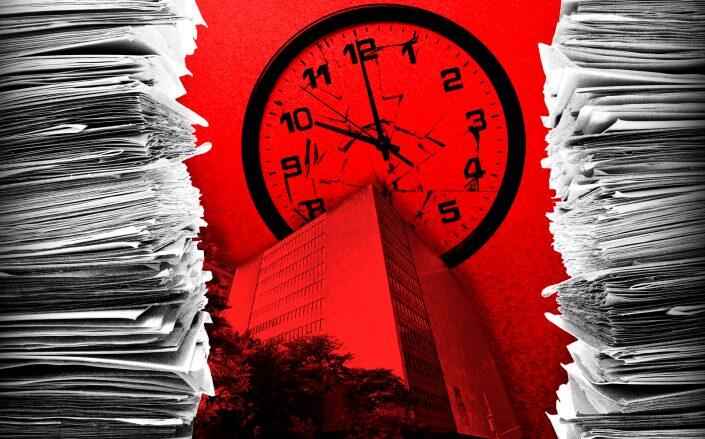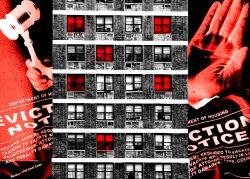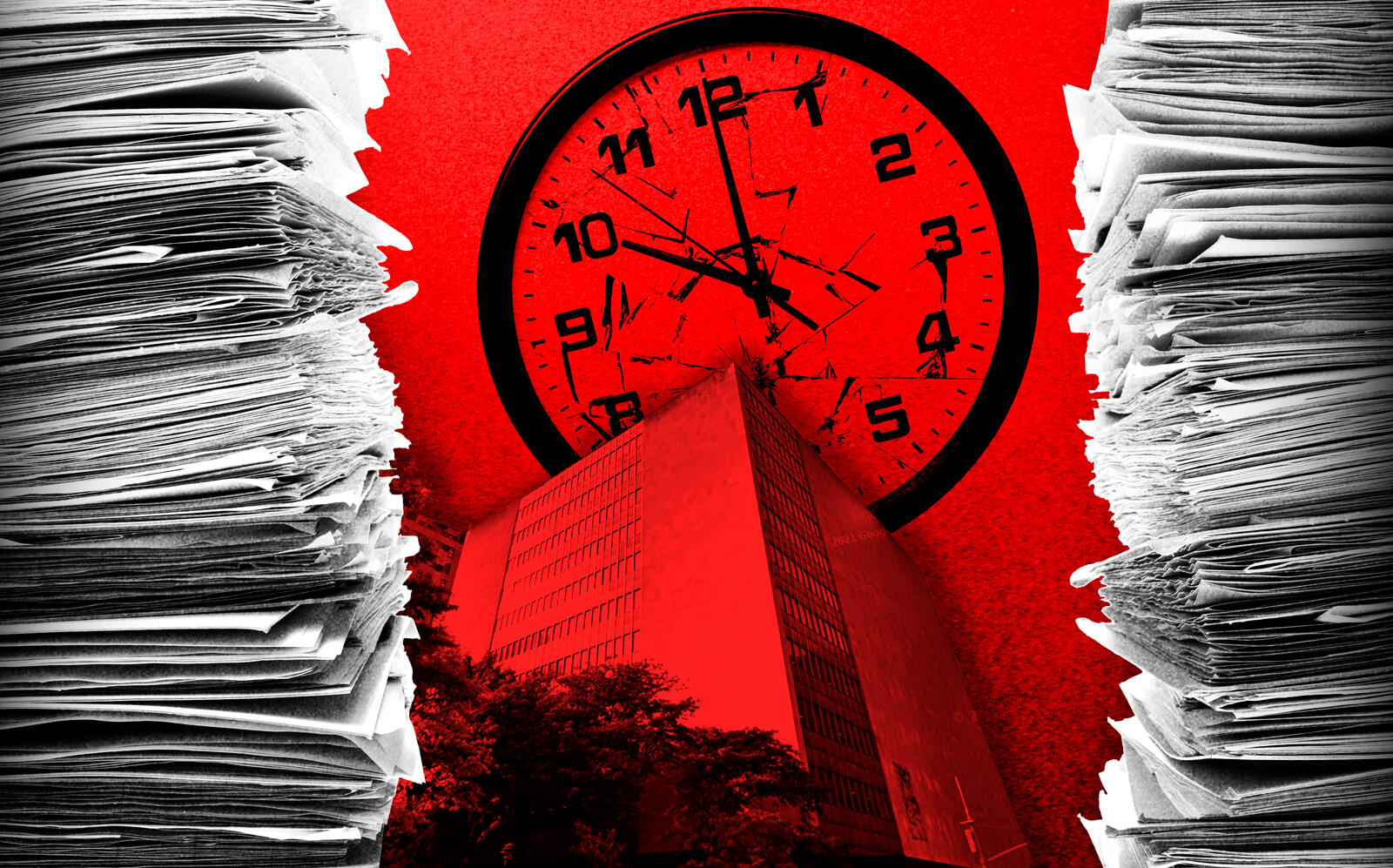
(Illustration by Kevin Rebong for The Real Deal/Getty)
Before the pandemic, housing court wasn’t exactly a well-oiled machine. But at least it moved.
Sitting on the eighth floor of the Manhattan Civil Courthouse, the landlord-tenant level, Martin Meltzer remembers the commotion almost fondly: spectators overflowing courtrooms, officers screaming to clear out into corridors that were often a combat zone.
“There used to be fistfights in this hallway,” the Belkin Burden Goldman attorney said. “If a lawyer was rude, tenants would not in any way hesitate to punch the lawyer in the head.”
But on a mid-May morning, apart from the occasional clack of a lawyer’s loafers, the hall was silent.
The few who had made the trek downtown would greet Meltzer with complaints that the court was mired by delays and that showing up in person was a waste of time.
“I love coming here just to adjourn cases; it’s such a useful exercise,” a sarcastic young lawyer quipped to Meltzer, whose own case had just been pushed back. “The efficiencies are just fantastic.”
Last year, as New York’s eviction moratorium was about to expire, the prognosis was chaos: Filings would flood the court system and tenants would be ousted from their homes en masse, housing advocates warned.
But six months since the twice-extended moratorium ended, eviction filings are not even at pre-pandemic levels. In the first half of this year, landlords have sued to evict two-thirds as many tenants as they did during the same period in 2019 and the court has issued far fewer warrants — just a quarter of those ordered pre-pandemic, court data show.
The chaos, however, has come in a different form: a backlog of at least 70,000 cases, the Legal Aid Society estimates. The pileup has strained landlords’ finances and their relationships with tenants, some of whom owe well into the five figures. Many small owners have contemplated leaving the business, and a number already have.
Administrators revoked another tenant-era protection and have pushed for all parties to appear in person.
Experts say those changes are at best, small potatoes; at worst, they could drive longer delays.
Judges’ shift favors tenants
Though postponements have always been part of the game, Meltzer said after Right to Counsel passed, judges became more apt to delay cases where tenants lacked an attorney.
The 2017 city law guaranteed free legal services for low-income tenants. Lawmakers intended roll the system out zip code by zip code, until all eligible city residents had access by July 2022.
It’s just destroying us.
But in 2021, the threat of an eviction “avalanche” spurred City Council members to speed the launch. That May, Mayor Bill de Blasio signed a bill that authorized an immediate citywide deployment.
Prior to that, Meltzer said, many judges would ask tenants at their first appearance in housing court whether they wanted a lawyer.
“The judges would say to the tenant, ’They have a lawyer; you don’t. They’re claiming you owe four months of rent at $2,000, so, $8,000. Would you like to discuss how to resolve that?’”
Often, the tenant would opt to work out a settlement sans counsel to get through the process more quickly.
But since the law passed, “most judges are not inclined to even have that first conversation,” Meltzer said. Instead, they pause the case so tenants can find an attorney.
Luise Barrack, head of litigation at real estate law firm Rosenberg & Estis, said the trend took off during Covid.
“It didn’t used to be that way if somebody came in and they weren’t represented and they didn’t ask for time to go get an attorney,” Barrack said. “But now, it’s more initiated by the court and by the judge’s law secretary.”
“And when the case gets adjourned, another month of rent accrues,” Meltzer added.
Shortage of lawyers
Tenants, though, are lucky if they find a free lawyer during that time.
In March, six weeks after the eviction ban ended, tenant attorneys criticized how quickly the court was scheduling cases, claiming they didn’t have enough lawyers to keep up. Five days into April, they said they could not take any more cases in Queens that month.
Adriene Holder, who heads the Legal Aid Society’s civil practice division, said her team is still playing catch-up.
“The thing that I think people keep forgetting is in March 2020, we were only responsible for 25 zip codes,” Holder said. The city has 145 zip codes.
Holder called Right to Counsel “the right thing to do,” stressing the benefit of having lawyers on both sides of an eviction suit. She said even landlord attorneys have acknowledged that mutual representation makes for smoother resolutions.
Read more



Tenant attorneys have also dealt with high turnover over the past two years.
“People are leaving all the time,” Holder said. “We have a second person going to pastry school. Some want to start families and don’t think they can do it in the city.”
Tenant attorneys’ fears that eviction cases would proceed without them have, for the most part, not been realized, largely because judges keep pushing lawyerless cases back. On other occasions, a lawyer will show up halfway through the process and the case will essentially start over.
A pointless exercise
In recent weeks, the Office of Court Administration has made a push for landlords, tenants and lawyers to appear in person.
Attorneys on both sides speculate the move is intended to speed up cases. They also agree that it won’t.
Barrack said the transition to in-person invites more delays, particularly if the court calls people in “when you know the tenant doesn’t have counsel and it’s going to be adjourned anyway.”
“That is certainly slowing things down,” she said.
Lucian Chalfan, a spokesperson for the state’s Unified Court System, said in-court hearings are usually scheduled for cases where both sides have representation.
However, Holder countered that most first appearances are now held in person. After that, a judge decides whether the trial will progress virtually, regardless of the litigants’ preference.
For tenants, an in-person trial can mean missing a day’s pay or shelling out for child care.
When the case gets adjourned, another month of rent accrues.— Martin Meltzer, attorney
And attorneys aren’t a fan of showing up for a conference only to find the tenant has no lawyer and the trip to court was a waste of time. For landlords, those pointless treks are still reflected as billable hours.
“If both parties want to remain virtual and it’s a benefit to our prospective clients, then I don’t understand why the court and certain judges can shut that down,” Holder said.
Come to order
In recent weeks, attorneys claim the court has reckoned with the glacial pace and tweaked systems to move things along. Its most recent move may be its most effective: In late June, it nixed an extra step landlords had to take to obtain a default judgment.
Before Covid, if a tenant didn’t show up to court, the property owner could fast-track an eviction proceeding by pursuing a one-sided trial, explained Altagracia Pierre-Outerbridge, whose eponymous law firm mainly represents tenants.
During the pandemic, the court instituted a buffer to protect tenants from that, forcing landlords to make a motion before pursuing a default. But now the court has removed that barrier for suits filed after the moratorium ended, allowing those quick evictions to resume.
“It takes about five to 10 minutes,” Pierre-Outerbridge said. “You just prove your position and the court issues a warrant.”
Chalfan said the court called for the change to resolve cases more quickly, which could be a win for landlords.
However, one leftover pandemic protection for tenants continues to create backlogs: the emergency rental assistance program, or ERAP.

Attorneys Martin Meltzer, Luise Barrack and Altagracia Pierre-Outerbridge
The program grants renters an automatic stay on evictions as soon as an application is submitted. It continues until the application is denied. Submissions that are incomplete or from ineligible tenants nonetheless convey temporary protection.
And as of last month, the state’s Office of Temporary and Disability Assistance, which runs the program, said it would only be able to review applications filed before April 1, as there isn’t enough funding for subsequent ones. That means several months’ worth of applications are likely sitting in purgatory, rendering landlords powerless to evict.
Because the program has also been mired by delays — some landlords who applied when ERAP opened last summer have yet to receive a payout — many property owners are waiting on money that may never come.
If funds ever do arrive, they won’t necessarily cover a tenants’ arrears. The program caps awards at 15 months’ rent, so if tenants continue to rack up debt while their application is pending, the eventual grant may only pay a fraction of what’s due.
To recoup the remainder, a landlord would need to sue again — and get in the back of the housing court line. Tenants could then, in theory, file another request for rent aid, earning another reprieve from eviction.
The incessant delays have taken a toll on owners’ finances, emotional and physical well-being, and willingness to rent again.
June and Lance Margolin, Long Island homeowners who rent out their top-floor unit, launched a survey last month asking owners how they had been affected by the emergency aid program.
More than a third of the 200 respondents reported a negative impact on their credit score. Some had drained their savings or borrowed money to pay mortgage, utility and repair bills.
One-quarter claimed a tenant had damaged their property while awaiting a payout; one-fifth said their renter has committed a crime. June Margolin alleges her tenant punched her in the face and ripped out a chunk of her hair after being served an eviction notice.
Most strikingly, when asked if owners would rent again, 40 percent of the survey respondents answered “no.” One-quarter said they were unsure. Among mom-and-pop owners, more than half had decided to exit the rental business.
“They’re just destroying the little guys with this program, the courts,” Margolin said. “It’s just destroying us.”
It’s unclear how many tenants have used the aid program to avoid eviction. However, immediately after the moratorium expired, judges were advising tenants appearing before them to apply. As of mid-July, the state had paid out fewer than half of the over 340,000 ERAP claims.
After the state initially shuttered the program late last year, claiming it had run out of funds, a judge ordered it to reopen applications in early 2022. The state has the power to stay that order and close the application portal, but has not done so, believing funding will materialize to pay more claims.
When that might happen and how many applications will be covered is unknown. In the meantime, tenants keep filing for aid, buying time before they enter what may be the worst slog New York’s housing courts have ever known.
